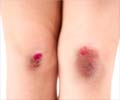Improving rearing environment of rats can significantly strengthen their physiological process of wound healing, a new study has found.
Improving rearing environment of rats can significantly strengthen their physiological process of wound healing, a new study has found.
In the study, researchers from the Benson-Henry Institute for Mind Body Medicine at Massachusetts General Hospital (MGH) and Shriners Burns Hospital found that giving rats living in isolation the opportunity to build nests led to faster and more complete healing of burn injuries than was seen in isolation-reared rats without nest-building materials.They also found evidence that this effect was linked to altered gene expression in stress-associated structures in the brain.
"These findings are consistent with other animal studies that show how stress and social deprivation reduce physical well being, but our study is novel in showing that the detrimental effects on physical health can be reversed by environmental stimulation" said John B. Levine, MD, PhD, of the MGH Department of Psychiatry, senior author of the paper.
Researchers conducted the new study to examine whether environmental enrichment can reduce the impact of stress on wound healing and to investigate associated changes in brain activity and behaviour.
Young rats that had just been weaned were placed either in cages shared with other rats or into isolation cages. Along with standard bedding materials, some of the isolated animals also received small squares of cotton called Nestlets that they would tear up and arrange into nests. The nesting materials were replaced twice a week, and each time the rats built themselves new nests.
An experiment designed to test wound healing found significant difference among these groups. Four weeks after a burn injury was administered under anesthesia, 92 percent of the group-reared rats had healed well, compared with only 12 percent of the isolation-reared rats without nesting materials. But among the isolation-reared rats given nesting materials, 64 percent were determined to have healed well.
A third experiment showed that the opportunity to build nests reduced the hyperactive behaviour typically seen in isolation-reared rats and also had effects in the hippocampus - a brain structure known to be key to the stress network - increasing the expression of genes previously shown to be under expressed in isolation-reared animals.
Source-ANI
LIN
 MEDINDIA
MEDINDIA



 Email
Email







